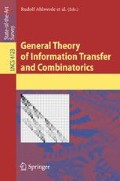Abstract
The coding problem for the multiple-access adder channel is considered, both for the case of permanent user activity and partial user activity. For permanent user activity, Khachatrian [10] has written an excellent survey for general, symmetric and non-symmetric rates. In this survey, we only deal with the special symmetric rate case, where all users have two codewords. The length of the shortest possible code is characterized, and amongst others, we present the code construction of Chang and Weldon [5]. We also deal with the case of signature coding (where we mean that one of the codewords for each user is the zero vector). As a code construction of this kind, we show Lindström’s one [12].
We also consider partial user activity. For this case, the resulting upper and lower bounds on the length of the shortest possible code differs by a factor of two. There are some constructions for suboptimal codes, but we do not know about constructions with length approaching the upper bound. The signature code is similar to the B m code examined by D’yachkov and Rykov [7]. It is interesting, that the upper and lower bounds for the length of B m codes are the same as for signature codes.
Access this chapter
Tax calculation will be finalised at checkout
Purchases are for personal use only
Preview
Unable to display preview. Download preview PDF.
References
Ahlswede, R.: Multi–way communication channels. In: Proceedings of the 2nd International Symposium on Information Theory, Hungarian Academy of Sciences, pp. 23–52 (1971)
Ahlswede, R., Balakirsky, V.B.: Construction of uniquely decodable codes for the two-user binary adder channel. IEEE Trans. Inform. Theory 45(1), 326–330 (1999)
Bose, R.C., Chowla, S.: Theorems in the additive theory of numbers. Commentarii Mathematici Helvetici 37, 141–147 (1962)
Cantor, D.G., Mills, W.H.: Determination of a subset from certain combinatorial properties. Canadian Journal of Mathematics 18, 42–48 (1966)
Chang, S.C., Weldon, E.J.: Coding for T-user multiple-access channels. IEEE Trans. Inform. Theory 25(6), 684–691 (1979)
Cover, T.M., Thomas, J.A.: Elements of Information Theory. John Wiley & Sons, Chichester (1991)
Dyachkov, A.G., Rykov, V.V.: A coding model for a multiple-access adder channel. Problems of Information Transmission 17(2), 26–38 (1981)
Erdős, P., Rényi, A.: On two problems of information theory. Publications of the Mathematical Institute of the Hungarian Academy of Science 8, 229–243 (1963)
Gallager, R.G.: Information Theory and Reliable Communication. John Wiley & Sons, Chichester (1968)
Khachatrian, G.H.: A survey of coding methods for the adder channel. In: Alth”ofer, I., Cai, N., Dueck, G., Khachatrian, L., Pinsker, M., Sárközy, A., Wegener, I., Zhang, Z. (eds.) Numbers, Information, and Complexity (Festschrift for Rudolf Ahlswede), pp. 181–196. Kluwer, Dordrecht (2000)
Liao, H.: A coding theorem for multiple access communications. In: Proceedings of the International Symposium on Information Theory (1972)
Lindström, B.: On a combinatory detection problem I. Publications of the Mathematical Institute of the Hungarian Academy of Science 9, 195–207 (1964)
Lindström, B.: Determining subsets by unramified experiments. In: Srivastava, J. (ed.) A Survey of Statistical Designs and Linear Models, pp. 407–418. North Holland Publishing Company, Amsterdam (1975)
Shannon, C.E.: Two–way communication channels. In: Proceedings of the Fourth Berkeley Symposium on Mathematical Statistics and Probability, vol. 1, pp. 611–644. University of California Press (1961)
van der Meulen, E.C.: The discrete memoryless channel with two senders and one receiver. In: Proceedings of the 2nd International Symposium on Information Theory, Hungarian Academy of Sciences, pp. 103–135 (1971)
Editor information
Editors and Affiliations
Rights and permissions
Copyright information
© 2006 Springer-Verlag Berlin Heidelberg
About this chapter
Cite this chapter
Laczay, B. (2006). Coding for the Multiple-Access Adder Channel. In: Ahlswede, R., et al. General Theory of Information Transfer and Combinatorics. Lecture Notes in Computer Science, vol 4123. Springer, Berlin, Heidelberg. https://doi.org/10.1007/11889342_9
Download citation
DOI: https://doi.org/10.1007/11889342_9
Publisher Name: Springer, Berlin, Heidelberg
Print ISBN: 978-3-540-46244-6
Online ISBN: 978-3-540-46245-3
eBook Packages: Computer ScienceComputer Science (R0)

